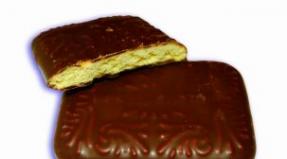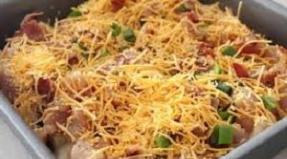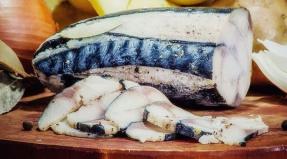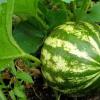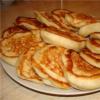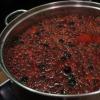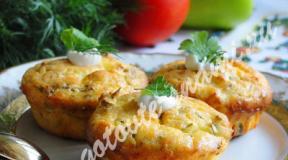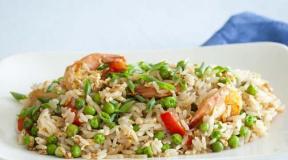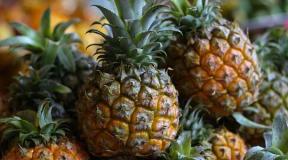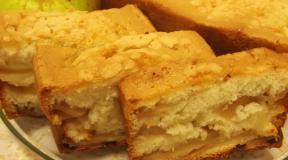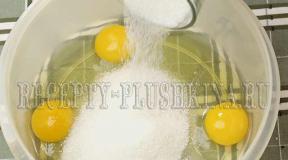Wheat flour: varieties and types. Wheat-rye flour
What is flour? Flour is a food product obtained by grinding grain into a powdery bulk mass. Flour is divided by type, type and grade, depending on the type of grain used, into types according to purpose, grades in accordance with the fineness of grinding and varieties of grains for making flour.
Flour, as you know, is a valuable food product, and without it it is impossible to bake bread, make a homemade pie, or make fluffy pastries. Knowing the types of flour, what varieties and types there are, what to look for when choosing, how to properly use flour for its intended purpose, you can learn how to independently classify flour products and cook tasty and healthy food with flour.
Testimonial advises. The darker the flour, the more it contains substances useful for the human body: proteins, minerals and vitamins.
In the milling industry, flour is made from various agricultural crops, mainly cereals. Flour is produced mainly from varieties of grain crops such as wheat, rye, barley, spelled, oats, buckwheat, corn, millet and rice.
In addition to those listed, there are other types of flour, but the bulk is made from wheat. Wheat flour is the basis of dough for bread, bakery products and is classified by grade.
What are the varieties of flour
The type of flour is determined depending on the yield (receipt) of the finished product from the grain. The flour yield is calculated as a percentage. The more flour comes out of the grains, the lower the grade and coarser flour is. If you grind 10 kg of grain into flour, then you get 8.5 kg of the finished product, and the flour yield will be 85%. The lower this percentage, the higher the grade of flour.
An indicator of the quality of flour, its types and types, is considered a grade. In the production of bread, as a rule, rye flour and wheat flour are used. Flour from cereals and cereal crops is included in composite mixtures and is used as an independent product.
Flour composition and properties
Flour, consisting of various impurities, has a valuable nutritional composition, enriched with dietary fiber, vitamins, macro- and microelements, is used to improve the taste of flour products and increase the energy value of the product.
When choosing flour in a store, pay attention to the packaging. On the packaging with high-quality flour, the composition should be indicated. If the flour consists of composite mixtures, read the information on the package about the composition of the mixtures, their percentage in the flour. Pancake flour, for example, contains additional ingredients such as milk powder, salt, sugar, baking soda, and dry egg powder.
Flour from various grains, from a mixture of wheat and rye (wheat-rye), from one culture has a different composition, we present the general indicators of the chemical composition of flour:
- starch - 54-90%;
- proteins - 14 (wheat) -44 (soy)%;
- fats - 0.9-4%;
- carbohydrates;
- cellulose;
- vitamins - B1, B2, B6, PP, A, E;
- dextrins;
- enzymes;
- minerals - 0.36-3.5%.
Flour is divided depending on its main properties, in accordance with the nutritional value, composition, technological characteristics, taking into account the raw materials used and the grinding of grain. Flour is classified by types and types.
Types of flour
The type of flour is simply determined by its intended purpose. Wheat flour is divided into three types, it can be:
- Bakery - a type for baking bread.
- Pasta is a type of flour used to make spaghetti and pasta.
- Confectionery - for making cakes, pastries and muffins.
Meanwhile, not all flour is intended for baking, not all types of flour are used in baking. Buckwheat flour and oatmeal are widely used in the preparation of infant formula, baked goods, pancakes and biscuits.
Rice flour is used for breading fish, meat and vegetables. Porridge is cooked from corn flour, casseroles are prepared. But wheat flour is considered the leader in production and consumption among other types of flour. What flour is usually made of:
- Wheat bread flour is made from soft wheat.
- Wheat pasta flour is obtained from durum grains.
- Rye flour is only used for baking. The main feature of the composition of rye flour is the high content of proteins, carbohydrates and mucus.
Flour is coarse and fine
Fine flour - flour from the inside of the grain. When finely ground flour is white, it usually contains gluten and starch, fiber in white flour contains a small amount. Fine grinding makes the flour tender; such flour consists of small particles of grains, the outer layer of which is removed. Wheat flour is considered to be flour:
- Highest grade;
- First grade.
Coarse flour - whole grain flour. When coarsely ground, the whole grain is completely ground into flour. It consists of large particles, in its composition bran and grain shells. Wholemeal flour:
- Wallpaper;
- Second grade.
Wheat flour: varieties and calories
Wheat flour is produced from wheat grains, the main purpose of the product in ready-to-ground form is to use it for baking bakery products and bread. Wheat bakery flour is divided into grades:
- grains;
- top grade;
- first grade;
- second grade;
- wallpaper flour.
In addition to the main 5 varieties, Podolskaya wheat flour, special bakery wheat flour of the highest and first grade are produced.
Wheat flour varieties differ among themselves in the main indicators, which have a different effect on the finished flour variety:
- color, smell and taste;
- humidity and zoning;
- type of grinding;
- the amount of bran particles content;
- pest infestation;
- acidity;
- the amount of gluten.
Energy value of wheat flour, composition of BZHU:
- Proteins: 10, 8 g;
- Fat: 1.3 g;
- Carbohydrates: 69.9 g.
The calorie content of wheat flour is 334 kcal per 100 g.
Rye flour: composition and varieties
Rye flour is of three types:
- Seeded. Seeded rye flour of white color with a characteristic cream shade. It is produced from the middle of the grain and consists of small particles.
- Rough. Peeled rye flour - white with a grayish tinge with particles of grain shells. Bread made from such flour is low-calorie, porous and tasty. Contains vitamins and minerals
- Wallpaper. Nutritionists consider rye wallpaper flour to be the most useful for human nutrition, nutritious. It has the highest bran content in comparison with other varieties. Flour of gray color with particles of grain shells. Used for baking bread.
The difference between varieties of rye flour and wheat flour is in the content of bran, the degree of grinding and the amount of product in the output. The less bran in rye flour, the lighter it is. But proteins in rye flour do not form gluten, unlike wheat proteins.
When making dough, rye flour absorbs more liquid than wheat flour. Bread made from rye flour turns out to be black and dense, gray dough, when kneaded, has a tendency to stick to your hands.
Besides the basic types and grades of flour, there are many different types.
Types of flour
Flour of other types is produced in smaller quantities than wheat flour. The flour used in baking is regular wheat flour. But some recipes include corn, barley, pea and soy; such flour is more often used in the preparation of traditional national dishes. Rice and buckwheat flour is used for baby food, dietary meals, separately as an independent product or in combination with wheat flour.
Different types of flour combined with other dough ingredients give different results. If a certain type of flour is indicated in the baking recipe, it cannot be changed to any other type and variety. The simplest and most common flour for baking bread, pies, rolls and pies is wheat flour.
To bake yeast bread at home, to cook it yourself, make it, draft, Austrian, you need to understand what kind of flour, its type, type and grade, for which baking is suitable.
- Semolina is a type of flour obtained from durum wheat, a characteristic feature of the product is the high content of gluten in the composition. Wheat grain semolina is used to make traditional Italian pasta. There is wheat, rice, corn flour, semolina is produced from any grain - corn, rice, wheat and others. Depending on the type of grain, the semolina is assigned an appropriate name.
- Spelled is a type of flour made from spelled wheat. Flour is used for baking, it is produced from wheat, but differs in nutritional value, easily digestible fats in its composition, in contrast to ordinary wheat flour. Spelled flour contains gluten, but tastes similar to whole grain flour.
- Abyssinian saucer flour is a type of flour made from an ancient type of grain under the unusual name Abyssinian saucer. Such flour has a valuable composition and is very nutritious, in appearance it resembles grains of quinoa or millet. The composition of the small grains of the Abyssinian teat contains iron, calcium, thiamine, and fiber. The protein content is higher than in wheat flour, from small grains the flour is gluten-free. The product has gained popularity with gluten intolerance sufferers, athletes and weight watchers.
Whole grain flour
Whole grain flour, or wallpaper, is a product of coarse grinding, produced from whole grains of wheat. Wallpaper flour contains more fiber, nutrients than white, and less gluten. Whole grain baking flour is most commonly used in a mixture with bakery flour in bread doughs.
Flour of the 1st (first) grade
Flour of the first grade is also called universal. It is this kind of flour that is most often bought in baking shops. Flour of the 1st grade is a mixture of soft and durum wheat flour. Premium flour is white and darker. White flour is used to bake pancakes, cookies, waffles. The darker one is used in the preparation of yeast-free and yeast-free pastries: breads, casseroles, puddings, sweet pastries, and profiteroles with eclairs.
Flour of the 2nd (second) grade
Grade 2 flour is good for baking. Wheat flour with a high (from all wheat flour) starch content and a low protein value. Finished buns made from second-rate flour are obtained with a delicate fluffy texture. Used for, muffins, lush cakes and yeast-free breads.
Flour of the highest grade bakery
Flour of the highest grade - white flour from durum wheat. Due to its high - up to 14% - premium flour is ideal for yeast baking. It is rich in protein, as a rule, it contains ascorbic acid, thanks to the acid content in combination with yeast, products from premium flour are porous and fluffy.
Krupchatka
Small grains without shells and powdery particles - grains. Flour is produced from special varieties of wheat, it contains a lot of gluten, due to which the grit differs from other flour with its high baking properties. Flour is used for baking such products as pastries, cakes, it is suitable for yeast dough, noodles, dumplings, but not for yeast-free bread.
The benefits and harms of wheat flour
The benefits and harms of wheat flour depend on the amount of baked goods eaten by a person. For flour to be beneficial, not harmful, it is necessary to choose the right types of flour for baking. Snow-white flour is the most useless for human health. White flour is a high-carbohydrate product, using which in excessive quantities, a person gets fat, a bun or pie eaten is quickly deposited in fat, causing harm.
Nutritionists, adherents of proper and healthy nutrition, recommend adding the first grade, the second or whole grain flour to high-grade flour when baking products. Baking from a mixture of several varieties of flour will reduce the harm of high-quality wheat.
How to store flour
- The storage of any flour must be correct. Store flour in a dry, cool and ventilated area.
- The shelf life of flour is indicated on the package, as a rule, it does not exceed 6 months.
- Whole wheat flour keeps better in the refrigerator.
- Flour should be stored in a closed jar, container for bulk products or sealed packaging. This storage method will help to protect flour from bugs and odors.
- In the hot season, it is better to place any flour in the refrigerator, otherwise it will quickly turn rancid at high temperatures in the kitchen.
- It is forbidden to eat flour if it has changed color, a foreign smell, bugs have appeared.
- You should buy flour as it is consumed, there is no need to stock up for future use.
Which gluten-free flour is best for baking
Replacing plain wheat flour with gluten-free flour allows celiac disease sufferers to indulge in the pleasure of eating a slice of cake and baking homemade bread. Gluten-free flour is suitable for baking gluten-free foods for people suffering from wheat flour intolerance. You can buy gluten-free bread mixes at the store, or you can mix individual items together yourself.
Knowing which gluten-free flour is best for baking, which mixture of different types of flour is best to use, any product can be made at home without hassle and make the baked goods as useful as possible.
- A mixture of starch, rice and tapioca flour is the perfect combination for baking bread.
- A mixture of two types of flour - white rice and tapioca - is recognized by the sweet tooth as optimal for baking cake layers.
- White rice flour is a popular neutral flavor product. It is more useful to use it not in pure form - in a mixture with another type of flour.
- Brown rice flour is a healthy type of flour, but the product is not for long-term storage.
- Buckwheat flour is prepared by grinding buckwheat grains and is widely used in recipes for baking homemade waffles, pancakes and pancakes. Buckwheat flavor can be weakened by mixing buckwheat with other types of flour.
- Corn flour is prepared in a similar way - by grinding corn grain. It is used for baking tortillas, making casseroles.
- Peanut flour is made from peanut nuts, from which oil was previously squeezed out. Flour is gluten-free, an excellent substitute for a wheat product. Used in cooking for making noodles and breads.
- Sorghum is a flour alternative to wheat flour. It tastes like wheat flour, but sorghum flour is gluten-free. It is used in recipes for any baked goods.
- Coconut flour is one of the healthy foods used for making desserts and sweet pastries.
- Nut flour consists of chopped walnuts, hazelnuts, or almonds. Flour is obtained by grinding almonds and nuts. In cooking, almond flour is found in recipes for making pralines, marzipans, and chocolate spreads.
- Quinoa and amaranth flour (amaranth flour) is considered one of the best options for baking bread, replacing wheat flour.
- Lentil or chickpea flour is famous for its valuable nutritional properties and beneficial composition. More suitable for baking tortillas.
- Flaxseed flour, along with flour from ground pumpkin seeds and sesame seeds, serves as an additive in gluten-free bread recipes.
- Oat flour. Oatmeal is made from oat grains. Oats are a cereal crop with a unique gift of nature and a healing composition. Flour obtained from oat grains is one of the most useful types of flour, it is considered more useful than other cereals. Oatmeal is good for baking cookies and pancakes. In combination with flax flour, the nutritional value of oat flour increases, the structure and taste of flour products improves.
Name of flour
Housewives are increasingly using various types of flour at home. The many types of flour, varieties and types of the names on sale, the range of bulk products raises questions from the housewives about the purpose of flour.
- Barley flour. Flour is made from barley in small quantities; in home life it is used to bake pancakes and flat cakes. Bread made from barley flour, in its pure form, quickly stale; the product is usually used in bakery production in a mixture with wheat and rye flour.
- The name pancake flour can be seen on packaging in supermarkets. In fact, there is no pancake flour. Pancake flour is a mixture of first grade wheat flour and often soy flour. Pancake flour often contains preservatives, baking powder, starch, and sugar and salt.
- Pea flour. Flour obtained from chickpea or pea beans is a valuable dietary food product. Flour is rich in proteins, vitamins and mineral salts. With the addition of wheat, donuts are made from pea flour, homemade cookies and diet bread are baked. The world famous Israeli falafel is made from pea (chickpea) flour.
- Bird cherry flour is used in cooking for casseroles, pies, and muffins. But such flour is suitable for baking bread and rolls.
In addition to the listed types of flour, varieties, types and names, there are other types, such as spelled, hemp, cedar, soy. The names of flour can be listed endlessly. It is important to remember that only wheat flour is suitable for use. For baking bread, wheat and rye are the basis, flour from other crops is used as an admixture to the main ones.
Otherwise, when making baking dough, try to use other flours and varieties with the main white wheat flour. Experiment with coarsely ground foods for richer baked goods and healthier ingredients.
For many centuries, people have tried to make flour as whiter, cleaner and finer as possible, and diligently got rid of the "dirt" and large inclusions that gave the hard parts of the grain - the shell and the germ. And finally, when mankind learned to separate the "husk" from the center (endosperm) and received a snow-white "powder", it became clear: an ideal product is useless. Most of the substances necessary for the body (vitamins, proteins, minerals, fiber) are concentrated in the shell and the embryo, and the endosperm is mainly starch, from which, by the way, they quickly recover. Therefore, when choosing flour, buy a product that is not only suitable for your baking, but also as rich in composition as possible. After all, as the owner of the famous bakery on Tverskaya, Mr. Filippov, once said: "For good bread, flour is even more important than a skilled baker."
Wheat - for biscuit
There are many different types of flour on sale today. But the most popular is still wheat. If you see the word “Farina” on the label of Italian products, it means that the package contains flour from soft wheat varieties, if “Semolina” is from hard wheat. These are very important designations, because the former is more suitable for bread and baked goods, and the latter is more suitable for pasta and pizza. Unfortunately, domestic products are mainly made from soft grains, and this is not indicated on the packaging. But, without fail, it is written what grade the flour belongs to.
Top grade. This flour is made not just from the endosperm, but from its central part. It is the whitest and smallest: the particle size is 30-40 microns. Only from it can an airy and porous crumb be obtained. True, do not expect the benefits of such baking, because the highest grade has a minimum ash content (this term is used by millers and confectioners from many countries of the world). It turns out that if the flour is burned, ash will remain. This incombustible residue is formed by minerals, which are found most of all in the shells of the grains. Since they are not in the highest grade, its ash content is no more than 0.55%. On domestic products, this indicator is almost never put, but in the West it is widely used. For example, on flour from Germany, you can see the designation "T550". These figures correspond to an ash content of 0.55%, which means that the product is similar to our premium grade. The Italian product has its own "hieroglyphs". For example, premium flour is designated "0000". If there are fewer zeros, then the grind is coarser.
First grade. The flour related to it is larger than that of the premium grade, its particle size is from 40 to 60 microns. It can be from pure white to white with a yellowish or slightly grayish tint. This is due to the fact that it contains a small amount of crushed grain hulls. The ash content of such flour is 0.75%. It is close to German products T812 (ash content - 0.812) and Italian 000 (ash content - 0.65%). Bread crumb is obtained from it from white to grayish hue, and the taste is highly dependent on the ingredients used and the art of the baker.
Second grade. This flour is even coarser and darker. Its color is from light with a yellowish tinge to dark gray and even brown. It has more shells, and the ash content is 1.1-1.2%. Of course, it is richer in vitamins and minerals, but it is rather difficult to bake something airy out of it. Therefore, it is customary to add flour of a higher grade to it.
Wallpaper... This flour is made from practically whole crushed grain. It contains both shells and an embryo. Its particles are not the same in size: the smallest - 30-40 microns, as in the premium grade, the largest - 2 times more, up to 60 microns. Bread made from such flour is the most useful, but it turns out to be harsh and non-porous. Therefore, it is "diluted" with other varieties and even a product from other cereals.
Krupchatka. This is a very coarse flour made from a mixture of hard and soft glassy wheat. It can be used to make noodles, dumplings or dumplings, but not bread. However, it is not very easy to buy this variety.
Rye - for black bread
For a long time, rye flour was used only for industrial baking of black bread. However, today it is increasingly "seeping" into home kitchens - it can be used to make cookies, pancakes, pancakes, pies, tortillas and other goodies. However, it is wrong to use it alone. Usually high-grade wheat flour is added to it. In accordance with the new GOST adopted in 2007, there are four types of rye bakery - seeded, wallpaper, peeled and special.
Wallpaper... Like similar wheat, it is almost whole grain. This flour is gray in color with inclusions of darker shells. Her ash content is as much as 2%.
Rough. This flour contains fewer grain hulls (some of them are stripped). Its color is grayish-white or grayish-cream, but even against this background, tiny particles of shells come across. Its ash content is 1.5%.
Seeded. She is more gentle. Shell fragments and other grain particles were removed from it. Color - white with a cream or grayish tint. Ashes in it are the same as in wheat flour of the first grade - 0.75%.
Special. This is under-seeded flour, so it occupies an intermediate position between seeded and peeled. This is evidenced by its ash content - 1.15%.
Barley - for pancakes
Barley flour was once super popular due to its cheapness. However, the bread from it turned out to be not too airy and soft and stale rather quickly, so they forgot about it. Today nutritionists advise adding it to flour made from other cereals. For example, with her participation tasty and healthy pancakes are obtained, because barley contains beta-glucan, which lowers cholesterol and protects blood vessels and the heart. They make it in two varieties - wallpaper or seeded. The first is almost whole grain, while the production of the second removes the bran (grain shells).
Buckwheat, oats and millet - for any dough
Buckwheat porridge is the healthiest one, and so is the flour made from this cereal. It is even officially called dietary. They make it like wallpaper and only one kind. True, it is quite difficult to make baked goods only from buckwheat - it will perfectly complement any other flour, and you will get great bread, pancakes, cookies, dumplings and, in general, all dough products. Oat or millet flour is used in the same way. By the way, the latter, for some reason, like porridge, is called millet, not millet.
There is no pancake flour
Today you can buy not only a product made from different grains, but also the so-called pancake flour. However, this term is incorrect - the mixture cannot be called flour. And when buying it, it is useful to pay attention to the composition. Often, such semi-finished products contain components that you are unlikely to use at home. For example, along with wheat flour, a pancake sometimes contains soy flour - it plays about the same role as egg powder or milk powder. In addition, blends are often made with artificial food additives, preservatives and leavening agents.
To prevent the bugs from starting
Flour is usually sold in breathable paper bags. Foreign, pancake and some mixtures are sometimes sold in plastic bags or cardboard boxes - it's good if the latter have transparent windows through which you can appreciate the appearance of the product. Having bought flour, store it not in cellophane, but in a “native” paper bag or pour it into a special container - glass, metal, wooden. Keep it in a cool dry place free of foreign odors. This means that the humidity should be no more than 70%, and the temperature should not be higher than + 20 ° C, otherwise the product will start to deteriorate, mold and bugs will start in it. However, even under ideal conditions, experts advise storing rye and pancake flour for no more than six months, and wheat flour - up to a year.
Expert opinion
Konstantin Spakhov, gastroenterologist, candidate of medical sciences
If you love baking, I advise you to stick to two principles. Firstly, use not only wheat flour, but try to experiment by adding other types to it - rye, buckwheat, barley, oatmeal. Secondly, do not refuse the product of a coarser grinding - wallpaper, peeled, second grade. All of this will help you discover new flavors and make your baked goods healthier.
What to look for on the packaging?
1. Variety. The higher it is, the better the quality of the baked goods, but poorer in composition.
2. The origin of flour- it is made of durum or soft wheat. True, this information is written only on an imported product.
3. Date of manufacture, conditions and shelf life.
5. Composition. It is required for flour mixtures and pancake flour.
The article presents the types and properties of flour: flax, soy, rye and others. How to choose flour for a healthy diet and which one is right for the desired type of baked goods.
In the previous publication, we dwelt in detail on the question and which one is better to choose. First of all, it depends on the type and grade of flour from which it is prepared. Today we will talk about the properties of different types of flour.
In the kitchen of almost every reader there is flour, from time to time used for cooking. However, can you answer the question, what kind of product it is, how is it useful and what properties it has? In fact, there are more than 50 types of flour in the world, each of which has its own unique advantages, and sometimes some disadvantages. Let's take a closer look at this issue. So, the types and properties of flour:
1. Flaxseed flour
In cooking:
Can be used as a dietary substitute for wheat flour. Requires less heat treatment, baked goods "ripen" faster. It is recommended to combine both compositions, replacing about 10-20% of wheat flour with flaxseed. It is useful to add to soups for thickening, sauces, use when breading and frying, cooking any porridge.Flaxseed flour: properties and benefits
A valuable dietary product, indispensable for fast and safe weight loss. Rich in easily assimilated fiber, which normalizes metabolism; contains safe omega-6 acids that prevent cell aging; saturated with B vitamins, potassium, magnesium, zinc and other useful microelements. In comparison with other types of flour, it contains much more protein, the building material of the body. Vegan food can be significantly enriched by the use of flaxseed flour. The sticky substances in flax seeds perform a mild laxative effect without disturbing the vital activity of the intestinal microflora. Flax phytoestrogens can have a positive effect on the regulation of the menstrual cycle and other cycles of the female body. Flaxseed meal should be used for cancer prevention as it contains lignans that inhibit tumor growth.Harm:
Has no side effects2. Soy flour
In cooking:
It is used as an inexpensive substitute for meat, fish, dairy products, used for making snacks, quick breakfasts. In small quantities, it can be added to any dishes, such as omelets, stews, soups.Benefits and properties:
Soy flour is the least refined of all legumes, but it is good for our body. It contains a record amount of fiber, as well as substances that effectively remove toxins. Soy flour contains up to 60% protein, as a result of which it can become a complete substitute for animal food. It also contains a lot of vitamins PP, A, E and B, beta-carotenes, iron, sodium, magnesium and phosphorus. Eating soy lowers cholesterol levels, prevents the formation of gallstones, normalizes fat metabolism, which leads to natural weight loss to an optimal level. Read more about it in one of our previous articles.Harm:
According to various sources, excessive consumption of soy can cause impaired reproductive functions, and during gestation increases the risk of pregnancy failure.3. Rye flour
In cooking:
Ideal for baking bread, as the dough rises even without yeast (leavened), it remains fresh, porous and elastic for a long time. Combining it with flaxseed flour, you do not need to add eggs to the dough, since flaxseed will replace protein. Rye flour is baked worse than wheat flour, so it takes some experience and a good oven to use it. It is added as a "link" in sour and spicy marinades.Properties and benefits:
In comparison with wheat, it contains more amino acids and is recommended for diabetics. Eating rye flour strengthens the immune system, improves intestinal motility and cleanses it. Linolenic acid in the composition protects against heart disease. In folk medicine, rye crumb treated abscesses, accelerated wound healing.4. Corn flour
In cooking:
Traditional cornmeal baked goods are not very good. But it is convenient to use it for breading, making "exotic" tortillas, lasagna, pancakes and casseroles.Properties and benefits:
This product is easily absorbed by the body and has a high saturation. It is rich in B vitamins, calcium and potassium, but contains less fiber than wheat flour. It is a gluten-free culture, beneficial for those with allergies.Harm:
More than other crops, corn is genetically modified. The composition of flour is poorer than wheat.5. Oat flour
In cooking:
The famous oatmeal cookies, pancakes, oatmeal jelly, porridge.Properties and benefits:
Contains less starch and more fat than other flours. In addition to the vitamins A, B and E typical for flour, it also contains choline, tyrosine, copper and silicon compounds. Eating oatmeal has been reported to increase serotonin levels and improve mood. Improves digestion and is less nutritious.6. Amaranth flour
In cooking:
It can be used as a substitute for any other flour.Combine them effectively in dishes.
Properties and benefits:
An exotic product for Europe, which came to us from South America. Due to this, it has a unique composition - a combination of amino acids and antioxidants that enhance immunity. It is saturated with fiber, contains up to 15% proteins and fats, contains biologically active substances (squalene, phytosterols). The record content of lysine in amaranth grain improves collagen production, renewal of integuments, and healing of injuries. Methionine protects against harmful radiation, protects the liver. Tryptophan improves mood and prevents depression. Gluten free product.Harm:
May cause individual tolerance, requires consultation with a doctor before taking.7. Buckwheat flour
In cooking:
Added to baked goods and pastries to prevent hardening. Enriches them with protein, vitamins, accelerates absorption. Buckwheat pancakes are a traditional Slavic dish.Properties and benefits:
Recommended for detoxification of the body, allergies, obesity, diabetes. Strengthens blood vessels, cleanses the liver, reduces the risk of constipation, and prevents overeating.8. Rice flour
In cooking:
It forms the basis of a huge number of dishes due to its unique qualities and snow-white color.Contains maximum starch without gluten and gluten, rich in sodium, potassium, phosphorus. It is useful for diseases of the gastrointestinal tract and cardiovascular system. Reduces the need for sugar and fats.
9. Pea flour
In cooking:
This dietary product can be easily obtained at home. To do this, you just need to grind dry peas in a regular coffee grinder. The resulting flour is convenient to use for making "pastry", baking, add to cereals and soups. Pea flour gives food an unusual pleasant taste. And when frying, it absorbs much less fat.Properties and benefits:
Pea flour is extremely rich in protein and can serve as a substitute for food of animal origin. Unlike the latter, pea flour does not contain cholesterol and costs significantly less. It contains a lot of fiber, vitamins A and C, magnesium, zinc, phosphorus, iron. Due to the content of such important amino acids as lysine and pyridoxine, the use of this product has a positive effect on the condition of the skin. Selenium in its composition protects the body from carcinogens.10. Whole grain flour
In cooking:
Used in the same recipes as wheat. However, whole grain breads are slightly less suitable and remain denser, with a pleasant aroma.Properties and benefits:
Essentially, any flour can be whole grain. This term means that the grain from which the product was obtained was threshed only once and was not subjected to additional purification. This method of making flour is closest to the "medieval" one used by peasants and villagers. Its advantage lies in the fact that the final product is enriched with vitamins and nutrients from the grain shell. This includes vitamins B and E, iron and manganese, increases the amount of protein and starch.Harm:
It all depends on what means the manufacturer uses for growing crops. Pesticides, heavy metals and harmful substances that negatively affect human health can accumulate in the shells of grains. Too large particles of peels in food can irritate the intestines or aggravate existing diseases.Although, if you decide to give up flour altogether, for one reason or another, then pay attention to.
How to choose flour
Let's summarize with some tips on how to choose the right flour. Of course, it all depends on the needs and tasks for which the product will be used.Wheat flour of the best grades "extra" and "superior" is ideal for delicate, soft, airy baked goods;
Wheat "grit" is number one when baking yeast baked goods, but not suitable for non-rich dough;
Wheat of the second grade is perfectly combined with rye flour, it is recommended for gingerbread, cookies;
Wheat of the first grade - for pies, pancakes, pancakes;
Buckwheat - for pancakes, casseroles, breading, baby food;
Flaxseed - in bread, minced meat, omelets, soups;
Oatmeal - for cookies and cereals;
Rice - for noodles, pancakes, baked goods.
Ash content and whiteness are interrelated indicators of the quality of flour, since both characterize the degree of purification of flour from coarse particles (outer layers of grain). High-grade flour has the highest whiteness and lowest ash content.
The lighter the flour, the higher its grade. Light flour produces bread with a lighter crumb.
Grinding size influences what kind of bread comes out. Excessively coarse flour absorbs water worse, the dough is formed more slowly, the bread comes out of insufficient volume with a coarse thick-walled crumb porosity and often with a pale-colored crust.
Falling number affects the baking properties of flour. The larger it is, the drier the bread is, the lower it is, the more sticky the crumb of the bread will be.
The highest proportion of gluten is in flour "Nastyusha" (31%).
Flour "Nastyusha", by the way, is the only one that corresponds to the declared grade and according to all other criteria in accordance with the requirements of GOST R 52189-2003.
- Other samples "did not reach" the declared premium grade in terms of such important indicators as the mass fraction of ash, grind size, falling number, whiteness.
Flour "Eating at home", in which the mass fraction of gluten corresponds to the declared variety, lagged behind in whiteness (52 instead of the minimum 54), in "Predportovoy"- excess of the mass fraction of ash. Also "Eating at home" and "Makfa" grind too coarse to be considered a premium. Have flour "Sokolnicheskaya" too small falling number - 156, and meanwhile, the minimum allowable - 185.
According to proven physical and chemical indicators Makfa and Predportovaya can only be considered second grade baking flour or general purpose flour. "Sokolnicheskaya" it does not fit into any quality standards at all.
- All samples were also tested for acidity. This is an unstandardized, but the most important indicator of the freshness of flour. It can be used to judge how long ago the flour was produced, what quality the raw materials were. If the acidity of the flour is high, then baked goods made from it will also have high acidity, which is highly undesirable.
Among the samples tested, flour has the highest acidity. "Sokolnicheskaya"(4%), the lowest in "Makfa" and "Nastyusha" (3%).
Every hostess who loves to bake something tasty should familiarize herself with this information, since the quality, taste and type of her future baked goods depend on it. Today we will talk about flour. Do you know which flour is best for baking? How to choose and store it? I propose to read the helpful tips of the hostesses, I want to tell you everything I know about flour.
What kind of flour is and what kind of flour to choose for baking
Literally all commercials assert that the best flour for most types of bakery products is wheat of the highest grade. You should not go about advertising that just wants to sell you the product that the manufacturer has.
In fact, there are a lot of varieties and types of flour, and each of them is more or less suitable for baking a certain product. For example, muffins, pastries and cakes are actually better baked with premium wheat flour. Uncomfortable pastries, as well as pies with various fillings, including sweet ones, are best baked from the first grade. Dumplings and dumplings, pancakes and your favorite pancakes are best cooked from the second grade.
Nowadays, it is not so easy to find the flour of the right grade, since most manufacturers only make it of the highest grade (some even simply write the highest grade, although it is not).
This is when it comes to wheat flour, but besides it there are many other types, which we will talk about a little later. There is a huge selection of flours that you can buy or make at home: almond, flax, nut, hemp, corn, barley, rye, soy and so on. You can list it endlessly! Each of them is good in its role, because it gives the dish a unique, inimitable taste and aroma. Therefore, you should not be afraid to experiment in order to find the best flour for yourself personally, with which each cake will become a work of art, and not a single pancake will be lumpy.
Wheat flour
Wheat flour is the most frequent guest of all types in our kitchen. It mainly consists of starch, but thanks to special proteins (glutein and gliadin), which combine with the liquid and turn into gluten (gluten), we get a dough from which we can bake delicious pies, pies, yeast and other baked goods.
To make a good dough from flour and liquid, it must be kneaded so that the gluten molecules at this moment can connect with each other and form long elastic chains. This transformation requires a sufficient amount of liquid for a certain amount of flour, kneading, salt and time to "rest" the dough.
Sometimes for the dough it will be necessary to minimize the formation of gluten, for this you will need to add very little liquid to the dough and knead it for a short time.
The amount of protein determines whether the flour will be "weak" or "strong". If we need "weak flour" to prepare the dough, then the protein content in it should be 10-12%. This indicator can be found on each package - the manufacturer is obliged to write. I think you have seen such an inscription on a pack before.

"Weak" flour is a common bakery flour for making confectionery products. The less protein it contains, the more crumbly and tender the finished dough will be.
If you need to lower the amount of protein and increase the amount of starch in the flour, then it's quite easy to do at home. Guess how? We replace some of the flour with starch (potato or corn). The amount of starch depends on what percentage of protein we need to get.
"Strong" flour contains 13-14% protein. It is most often used for making yeast dough. It is made from more rare and expensive varieties of wheat. It makes an excellent puff, choux and puff pastry, as this flour contains more protein, and the dough produces more gluten and more long elastic chains. The dough is stronger, stretches easily and does not tear.
“Strong flour” is hard to find here, so you need to look for Italian and Finnish producers.
In addition to protein, flour has another important component - starch. It is an excellent thickener that will show its properties when the temperature rises (during baking) if the right amount of liquid is added. The starch makes biscuits, casseroles, puddings and muffins delicious and tender. Therefore, you can often find starch, which replaces part of the flour in order to make the biscuit better.
Varieties and types of wheat flour
Top grade. Flour consists of the central part of the grain, which contains a lot of starch, but very little vitamins. Only it can make a lush cupcake or biscuit. Moreover, in order to increase the amount of starch, it is additionally added, replacing part of the flour. Particle size - 30-40 microns, ash content - no more than 0.55%. White color. Prepare pastries, as already mentioned, muffins and biscuits, cakes.
First grade. Contains a little crushed grain hulls, so it is slightly healthier than the premium grade. Particle size - 40-60 microns, ash content - 75%. The color is white, sometimes creamy with yellowness, rarely grayish. Suitable for making uncomfortable pastries (bread, lean rolls, kulebyak, pies with a filling and pies).
Second grade. There are already more grain shells in the flour mass. than in the previous forms. The grinding is coarse enough. She looks rude. The color is gray, sometimes creamy and even brown. They make waffles, dumplings, cookies, pancakes and pancakes from it. The dough turns out to be coarse, and the pastries get stale quickly. Not suitable for making biscuits or muffins. It is better to mix the second grade with the highest or the first, so that the products are more lush. Ash content - 1.1-1.2%. This variety is mixed with rye flour to make rye baked goods.
Wallpaper or whole grain. The most useful, as it contains the most useful parts - the embryo and shell. The particle size is 30-60 microns. Products made from it are tough, so whole grain flour is mixed with the first, second or even the highest grade.
Krupchatka. It is very difficult to buy it. They make noodles and dumplings from it. Not suitable for making bread (non-flavored yeast baked goods). Products made from it become stale very quickly, and the dough itself does not rise well.
How is whole grain flour different from regular flour?
Whole grain - one that was obtained by a single grinding of wheat grain together with the shell or any other cereals, has a fairly high level of gluten. It is considered one of the most useful types of flour (much more useful than ordinary flour). It is dark and rough and requires more moisture than normal. Whole grain dough cannot be elastic, and finished products are coarser and harder. It is rational to use for the dough whole grain and premium flour in equal quantities, unless otherwise provided by the recipe.
What is flour other than wheat

- Buckwheat. It is gluten free and is a favorite among dieters. Very pleasant to handle, it has a slightly nutty smell. Now, if you are asked what kind of flour is gluten-free, you can confidently answer - buckwheat.
- Rice. It is made from grains of rice, by grinding, two types of rice: standard white and brown brown.
- Barley. Has a light nutty taste, makes baked goods soft. It is suitable for making pancakes, biscuits and quick breads.
- Rye. It absorbs a lot of water, making the dough sticky. Bread is baked from it, which turns out to be denser with a characteristic taste and aroma. In addition to bread, it is used to make muffins, rolls and pancakes. According to the degree of grinding and the content of bran, it is divided into varieties: peeled, seeded and wallpaper. If before you did not know what wallpaper flour means, now you will know that this is one of the types of rye flour.
- Corn. There are two types: fine grinding, from which a beautiful yellow baked product is obtained with a characteristic delicate corn taste, and coarse grinding, from which dense and slightly grainy bakery products are baked. Most often, Mexican tortillas, bread, rolls and other baked goods (even dietary ones) are prepared from corn flour.
- Soy. It can be fried (with a bright taste) and not fried, which I use to make yeast bread. It has a white color, and products made from it do not stale for a long time and have a beautiful crust. Can replace eggs and milk in dough.
- Spelled or spelled flour (spelled). It is made from wild wheat varieties. They cook buns, pies, and pizza.
- Oatmeal. Can be made by pitching oatmeal in a coffee grinder. Used to make oatmeal cookies.
- Almond. Made from almonds. It is difficult to buy, but you can cook at home. You can make pies from it, as well as the famous macarons.
- Linseed. Has a distinct nutty flavor. Sometimes this flour is substituted for eggs, as it has good binding properties. Add to puddings, casseroles, bread.
How to choose flour

To choose a good flour product that will be stored for a long time without losing its properties, and products made from it will be tasty and healthy, you need to be able to choose. Please pay attention to the following points:
- Environment. The room in which flour products are sold must be dry, clean, free of foreign odors and high humidity.
- Shelf life. Without preservatives, flour can be stored for 6 months. Don't trust the manufacturer. who wrote that the expiration date is 1 year or more.
- Colour. Must match the type and variety. For premium wheat, it is white with a slight creamy tint. If you drop a drop of water on the flour and it turns blue, then this is a clear sign that it was made from unripe grain. If the color during the experiment is not blue, but red, then bran was added to the composition. If the color has not changed, then we are dealing with a quality product.
- To the touch. Squeeze the flour mass in a fist. It should crunch. If, after unclenching in your palm, the mass turns into a lump, then this is a clear sign that it is wet. Such a product has lost the desired properties and there is no need to buy it.
- Smell. Should be pleasant, matching the aroma of flour. There should be no smell of rot, mustiness or sour dough.
- Taste. Good wheat flour has a sweetish taste. If there are impurities in it, then they can crunch on the teeth.
Why is flour bitter or how much flour is stored

After you bought a flour product, you need to find out how to store it correctly, otherwise the product may deteriorate and become bitter, absorb foreign odors, and absorb moisture from the indoor air. This product is not suitable for use and must be discarded. Therefore, it is not recommended to purchase flour for future use.
- Storage must necessarily take place in a dry and cool place. The storage period is generally limited to about six months. Do not store the flour mass open to avoid oxidation of oils. Because of this, all properties of the product are violated.
- You need to store it in paper bags or linen bags. Do not store in polyethylene!
- If you are pouring flour from a bag, then always choose a jar with a lid that closes very tightly! It is also allowed to freeze flour for forty-eight hours in order to get rid of all insects and destroy their eggs. It is not recommended to mix flour that was opened a long time ago with flour from a new package, it is better to completely get rid of the old one before starting a fresh batch.
- Do not store near household products: soap, washing powder; also, you do not need to store it next to onions, because all these products emit a pungent smell, and the flour absorbs everything very quickly.
- It is allowed to freeze flour products in the freezer. Thus, extending the shelf life by two or three times.
- Temperature changes should not be allowed (especially sharp changes when condensation forms and the flour mass becomes damp).
- It is imperative to keep whole grain flour in the refrigerator, because at elevated temperatures, even if it is room temperature, the oils contained in the flour give it a bitter taste.
- Be sure to throw away flour if it changes color or smell.
- There is one tiny trick: to protect against insects, put a small bay leaf in a container of flour, because these plants are a weapon for eliminating insects. For the same purposes, you can place heads of garlic next to the flour.
- The optimum temperature is +18 degrees. If you store the flour mass at a temperature of 0 degrees, then the shelf life will no longer be 6 months, but 2 years.
Now I think you know all about flour. You know how to choose flour, how to store it, what it is and which flour is best for a particular baking. I am pleased to invite you to other sections of my site, where you can find delicious baking recipes and apply the new knowledge gained from this article.
Read also ...
- Recipes for making coffee with ice cream at home
- Strawberry panna cotta - a classic of world culinary What is panna cotta with strawberries
- Cream of curd cheese for cake - the best recipes for impregnating and decorating dessert
- Profiterole recipe and three original custard recipes Protein cream for profiteroles
